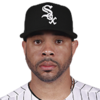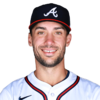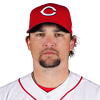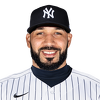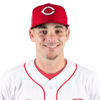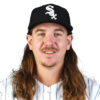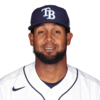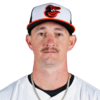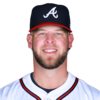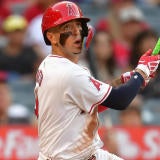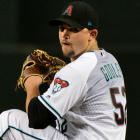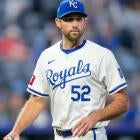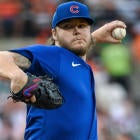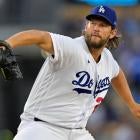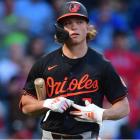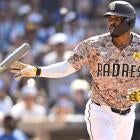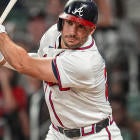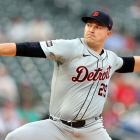Draft Prep Tiers: C | 1B | 2B | SS | 3B | OF | SP | RP
Heath's Breakouts | Busts | Sleepers | Scott's Top 100 prospects | Breakouts
It's pretty clear what I'm after here: value, in any form I can get it.
My Sleepers depart from my Breakouts (which you can find here) in that way. It's sort of a rectangle-square relationship. "All squares are rectangles, but not all rectangles are squares." You've heard it before.
So these aren't my only sleepers, but they're the ones that didn't really fit as breakouts, either because they've already broken out or because they're getting so little attention that the Fantasy Baseball world is, well, sleeping on them.
And that's the most common way a player outperforms his draft position: Going in the late rounds makes for an easier bar to clear and easier inclusion here. But whether a player is drafted in the fourth round or the 44th round, if he's better than that, it's a bargain.
And that makes him a sleeper in my book.
It seems every year a player who I thought we all decided had already broken out instead gets the cold shoulder from an industry too willing to hedge on what it didn't see coming, forcing me to double down on what I know to be true.
And this year, that player is Tommy Pham. He's currently 65th in FantasyPros consensus rankings, with nearly half of those polled ranking him outside the top 80.
In terms of overall impact, he was Cody Bellinger last year. You may not have noticed given that his promotion last May, just the latest of several return trips, was merely a footnote and came without the hype and hoopla of a 22-year-old making his major-league debut. He didn't get the Home Run Derby invite, he didn't get the postseason hardware, but by golly, he produced -- basically the same number of Head-to-Head points per game as Bellinger over basically the same span of time.
And he did it in a wider variety of ways, his superior contact rate giving him a plus batting average and his proclivity on the base paths making him a 20-20 man -- neither of which speaks to his most valuable contribution of all, which was reaching base at a .411 clip.
And again, he did in five months' time.
Now, some will tell you that for a 29- year-old whose previous stops in the majors made no lasting impression, these numbers are too good to be true, but they may not be accounting for the entire Pham saga, which featured an appropriate amount of hype in his teenage years, followed by a litany of injuries and eventually vision problems. Even as recently as three years ago, I saw noted prospect guru John Sickels compare his upside to Eric Davis.
The point is Pham was long a sleeping giant who just needed that final nudge to wake up. Proper management of his eye condition, called keratoconus, proved to be exactly that. The abnormal shape of Pham's corneas changes the way he processes images. He's legally blind in his left eye, according to the St. Louis Post-Dispatch. A special set of contacts uniquely mapped for his eyes, to take their shape, made all the difference.
Of course, you'll also find naysayers who look for flaws not in the performer but the production itself:
2017 he was the 17th overall hitter with a .368 BABIP, 26.7 HR/FB%, and hitting 51.7% of his balls in play on the ground. If he repeats his 2017 while maintaining that profile, I'll lose but he's more likely to see major regression
— Walter McMichael (@realfakewalter) January 5, 2018
To which I respond, yes, it's not the best sign for Pham's power production, but by the same token, if so few of his fly balls are staying in the park, thereby resulting in outs, and he sustains the line-drive rate and all-fields approach of a year ago, he's predisposed to a high BABIP and, with it, batting average.
And then there's the stolen bases. And the walks. Not to mention the fact that his month-to-month production was straight Trout-like, making it, if indeed a mirage, the most perfect mirage the world has ever seen:

Pham has proven to be so good in so many ways that he could slip in one area and still produce early-round numbers. To me, it's just a matter of him staying healthy.
You may wonder how a guy who once finished third in AL Cy Young voting (2015) could rise to never-before-seen heights, as a breakout is supposed to do, but remember: There was plenty of skepticism surrounding that 2015 performance, just as there was for the actual winner, Dallas Keuchel. Both he and Sonny Gray were pitchers out of their time, relying on weak contact even with strikeouts rising to unprecedented levels. And you need only a rudimentary understanding of statistics to recognize that no contact is better than some, no matter how weak.
So it wasn't the shock of the century when Gray's ERA ballooned to 5.69 the following year. In fact, judging from where he was drafted last spring, many thought he was done as a Fantasy standout. But last year, he regained some of his standing -- enough for the Yankees to give up three legit prospects for him in a deadline deal and enough for Fantasy owners to recognize that he still has value.
You may not realize how much, though.
With his resurgence, Gray continued to do the one thing he always did well: keep the ball on the ground, thereby preventing the big hit and theoretically the long ball at a time when home runs are also reaching unprecedented levels. His ground-ball rate wasn't in a different stratosphere, like Keuchel's, but it was fifth-best among qualifiers.
He also last year did the one thing he never did well, which is miss bats. I'm talking beyond just the career-high 8.5 per nine innings, which is hardly exceptional by today's standards. His swinging strike rate, buoyed by increased slider use, was nothing short of elite, ranking 17th among qualifiers when his previous high would have ranked only 67th. For as much as his strikeout rate improved, it could have -- and perhaps should have -- been even more.
And that's just one of the stealthy ways Gray got less than he deserved in his supposed bounce-back year. An unusually homer-prone September (when his ground-ball tendencies went on a hiatus) inflated his season-long rate, negating the effect of all the ground balls. He nonetheless delivered a 3.72 ERA in his 11 starts with the Yankees but still went only 4-7, leaving him with a 10-12 mark for the season.
Have you seen the Yankees roster this season? They had the second-best offense in baseball last season and then added the reigning NL MVP to it. They have five closer-caliber relievers in Aroldis Chapman, David Robertson, Dellin Betances, Tommy Kahnle and Chad Green. They're uniquely equipped -- as much as any team I can remember -- to hand a starting pitcher a lead and then preserve it for him. There's no way Gray is under .500 again, and I'll be shocked if he wins less than 15 games.
So to recap: A pitcher who stood out by so much in one area that it nearly won him a Cy Young award is now beginning to stand out in another while also finding himself with the best supporting cast in recent memory. I dare say the best is yet to come.
Lost in the spectacle that was Rhys Hoskins last August and September was a green-clad man doing red-blooded things, specifically homering 16 times in 23 games during one four-week stretch.
Zoom out further, and he hit 20 home runs in the span of 36 games. Zoom out further, spanning his full stay in the majors, and he hit 24 home runs in 59 games. Zoom out even further to the entire 2017 season, minors and majors included, and he hit 47 home runs in a span of 128 games.
And my heart went pitter-patter.
I'm not one of those Fantasy analysts who tends to value players solely on the basis of how many home runs they can hit, but even in the age of the home run, that is some uncommon power. And you have little reason to doubt it. Olson consistently elevated the ball (his fly-ball rate, according to FanGraphs, would have ranked 14 if he had the at-bats to qualify), he consistently pulled the ball (his pull rate would have ranked fifth), and he consistently squared up the ball (his hard-contact rate would have ranked 17th). It's a textbook power profile for a player who previously had a 37-homer season in the minors
What clinches it for me is that the strikeouts weren't the problem I thought they'd be. His 27.8 percent rate is below average, but compare it to other prodigious sluggers like Joey Gallo, Aaron Judge or Chris Davis, and he might as well be Ichiro.
I supposed you could argue he's too homer-dependent, having just two doubles to go along with his 24 homers in the majors last year, but the guy clears fences everywhere he goes. I don't see why it'd stop now. He was on like a 70-homer pace as a rookie, which is obviously too good to be true, but what isn't? 45? 50? This side of Giancarlo Stanton and Judge, Olson might be the best bet for that lofty total.
The story of Zack Godley's sleeper appeal is similar to that of Sonny Gray with one critical exception: He doesn't need to do more than he did last year to realize it.
People just don't, ahem, realize it. For starters, he somehow went 8-9 for a contending Diamondbacks team. There's also the matter of him entering last season as a complete nobody -- an organizational depth type who might make a spot start here and there -- but that was, of course, before his transformation.
You could make the case he was underrated to begin with, as often happens for sinkerball prospects, with former Diamondbacks ace Brandon Webb being chief among them. Godley was always able to generate ground balls, and last year's rate, according to FanGraphs, would have ranked seventh among qualifying pitchers. What changed was the increased use of a curveball to generate swings and misses, and it generated them aplenty, giving him what would have been the sixth-best swinging strike rate among qualifiers, according to Baseball-Reference, ahead of Chris Archer, Carlos Carrasco, Stephen Strasburg, Luis Severino and even Clayton Kershaw.
All Godley has to do to become a big winner for a good ballclub is continue down last year's path of run prevention, which is a reasonable expectation for a pitcher with his home run-avoiding, bat-missing tendencies. His 3.41 FIP pretty much tells the story there.
In today's landscape, an out-of-nowhere pitcher with these tendencies is like manna from heaven above, and he should own it every time he steps out of dugout. Take the mound, let his beard down and say, "In there, I am Godley, but out here ..."

And who would argue? Nobody, that's who.
"Well, I guess I'll be talking down Marwin Gonzalez next year."
That's what I said to myself -- alone, in the dark -- when I first started ranking players for 2018 last September. I saw the .907 OPS, the fact he would retain shortstop ability, and the reasonable strikeout rate and assumed people would go overboard for a player who's ultimately just a super-utility guy.
But now I see he's only 188th in FantasyPros consensus rankings, behind the likes of Trey Mancini, Dexter Fowler and Javier Baez, which compels me to take a different tack.
Guys, he had a .907 OPS last year, and he's shortstop-eligible!
I'm not even sure playing time is the issue I worried it'd be in September, He went on to start every one of the Astros' 18 postseasons games, and right now he's the best option they have for left field. It doesn't mean he'll be their everyday left fielder -- manager A.J. Hinch has discussed rotating his star players in the DH spot to make better use of Gonzalez's versatility -- but he'll play almost every day for as long as he deserves to.
And yes, it's fair to wonder if he'll always deserve to given his track record. And yes, his second half, while still yielding a respectable .848 OPS, confirms that he benefited from an impossibly hot start power-wise. But again, the batted-ball data mostly supports what he did, right down to the low strikeout rate (the BABIP was a little on the high side, but nothing excessive), which makes the probability of him doing it again high enough for me to target him as a top-12 shortstop and not some sideshow, especially given his quadruple ability -- a rare find at the start of the year.
Chris Taylor was just as surprising last year, had a higher strikeout rate, is lacking the shortstop eligibility and arguably has more threats to his playing time, and yet he's ranked about 80 spots higher. Go figure.
I don't doubt people see the 27 home runs and 97 RBI that Scooter Gennett contributed last year. I suspect they're desensitized to those numbers in today's offensive environment. It's more like "well, 20 home runs aren't worth much these days, and besides, he'll never do it again."
But I think they'd be surprised to learn just how impactful those numbers were. Remember: Gennett started out as a bench player last year. On June 5, thanks in large part to sporadic playing time, he had just three of those 27 home runs. It wasn't until the next day, his historic four-homer game, that Fantasy owners took notice, and the response then was universal dismissal.
So let's just look at what he did thereafter. Let's eliminate the historical outlier and assess only the aftermath. From his move into the lineup June 18 through the end of the season -- a span of 87 games -- Gennett hit .298 with 20 home runs and an .886 OPS. His 3.30 Fantasy points per game during that stretch would have been the fifth-most among second basemen for the entire season, behind only Jose Altuve, Jose Ramirez, Brian Dozier and Daniel Murphy -- i.e., the ones everybody's looking to draft in the early rounds.
Needless to say, he wasn't a reserve or even a part-timer by season's end. He was the Reds' everyday second baseman, and now with shortstop freed up for Jose Peraza, he doesn't have much competition for that role.
And while I can't rule out the possibility he just got lucky for 3 1/2 months and can even admit he's likely to regress some given his track record, I don't see any red flags in the batted-ball data. He simply began to hit the ball harder and higher at an age that makes sense and in a venue that rewards it.
At 191 overall, why the heck not?
I suppose I owe the Indians a thank you.
Heading into 2018, my initial assessment of Mike Clevinger -- just a base assessment of the numbers -- placed him 42nd among starting pitchers, third-best among Cleveland's lot because, well, that's what he was last year.
It didn't even cross my mind that their third-best pitcher -- owner of a 3.11 ERA in 21 starts (and six relief appearances) -- wouldn't have a job to begin the year, but because Danny Salazar and Josh Tomlin are still kicking around and the Indians haven't bothered to make any declarations, the assumption among the many roster trackers here on the World Wide Web is that Clevinger will begin the year in either the bullpen or the minors.

It's stupid. It's all stupid -- stupid that so many forecasters would actually predict it and stupid that they may actually be right. And for the record, it sounds like Clevinger himself isn't buying it:
"I'm not even thinking about the bullpen," he told MLB.com. "I want to throw 200 innings."
Yeah, maybe every pitcher competing for a job feels that way: like he's the rightful winner no matter how the competition plays out. But Clevinger has to be wondering what more he could have done to secure the job.
Here's the complete list of qualifying pitchers who averaged more than his 10.1 strikeouts per nine innings last year: Chris Sale, Robbie Ray, Max Scherzer, Corey Kluber, Chris Archer, Jacob deGrom, Luis Severino, Stephen Strasburg, Clayton Kershaw, Carlos Carrasco and Jimmy Nelson.
Here's the complete list of qualifying pitches who had better than his 21.9 percent swinging strike rate, according to Baseball-Reference: Max Scherzer, Robbie Ray, Corey Kluber, Masahiro Tanaka, Chris Sale, Zack Godley, Chris Archer, Clayton Kershaw and Carlos Carrasco.
Here's his number of quality starts over just his final 13: nine.
Here's to common sense reigning in the end.
While the Cardinals have been linked to most every first baseman on the block this offseason, I'm not sure they wouldn't be better off with what they have.
I don't know what they were watching that final month when they did in fact turn regular duty over to Martinez and saw him hit .353 with four home runs and a .986 OPS, averaging about as many Fantasy points per game during that stretch as Jose Abreu did for the season. It wasn't a great departure from what he did as a part-timer, just with increased exposure and increased opportunity to fail. The end result was a .309 batting average and .897 OPS.
And while you may say "well, his success was built on a .350 BABIP that's obviously unsustainable," my response would be "is it?"
Martinez's 26.6 percent line-drive rate, according to FanGraphs, would have ranked fifth among all qualifiers last year, and six of the top nine had a BABIP of .340 or better. Shoot, Freddie Freeman has made a name for himself off that kind of line-drive rate, and his career BABIP is .341. Meanwhile, only three of those nine hit the ball the opposite way as often as Martinez. One was Miguel Cabrera, whose batted-ball tendencies were suspiciously out of line with his production. The other two were Joe Mauer and DJ LeMahieu, who managed to hit over .300 despite offering considerably less power than Martinez
Looking at it that way, his batting average may have been on the low side last year, and when you consider also he struck out at a Freeman-like rate, well, the guy can hit. There's no question, He might even contend for a batting title if he got the chance.
It's just a question of opportunity.
It won't come in the outfield now that Marcell Ozuna is on board, so it has to be at first base, where the Cardinals would prefer to play Matt Carpenter. But they showed down the stretch that they're willing to move Carpenter back to third base to get Martinez's bat in the lineup. For the price of a late-round pick, I'm hoping they'll do it again.
Wait, what? Those are his minor-league stats?
What are we doing here? What's so special about J.P. Crawford? Why are you telling me he's some kind of sleeper when his numbers are making me some kind of sad?
Because those numbers don't tell the whole story.
Yeah, it was bad, but you know what was worse? Crawford's 2016 at Triple-A Lehigh Valley, when he hit .250 with a .688 OPS.
Not helping, am I? OK, but listen: Even throughout those struggles when he seemingly forgot what to do with that stick in his hands, the true prospect gurus out there -- the ones who build entire publications around their prospecting abilities -- never blinked. Heading into 2017, after that first dreadful year at Triple-A, Crawford was the No. 12 prospect for Baseball America, No. 7 for MLB.com and No. 4 for Baseball Prospectus.
See, throughout those struggles, he continued to excel at the most important skill of all: putting the bat on the ball. He struck out just 80 times in 472 at-bats at Triple-A in 2016 and 97 in 474 at-bats last year. Having already cleared that hurdle, his athleticism still had a chance to set him apart if he could just figure out what he was doing wrong.
And lo and behold, he did. Working with minor-league hitting instructor Sal Renden, he dropped his hands and moved them closer to his body, speeding up his bat to give him a .283 batting average, 13 home runs and .916 OPS in his final 59 minor-league games. It earned him a late-season callup and precipitated the Freddy Galvis trade this offseason, freeing up the shortstop job for him.
There's a real chance he's fixed now, which puts him back on the same track as Corey Seager and Francisco Lindor -- those prospects we mentioned in the same breath a few short years ago. A comparable breakthrough isn't terribly far-fetched, but because his turnaround is disguised in the season-long numbers, not to mention the worrisome two-year trend and the fact most of his major-league time came at third base last season (making him ineligible at shortstop to begin the season), he's not getting hyped as he should.
It's up to you to capitalize.
Austin Hays wasn't known even to dynasty league owners at this time a year ago. A third-round pick in 2016, he was kind of just another guy in the Orioles system. But numbers like he put up in 2017 will catch anyone's attention. His 32 home runs tied for second-most among minor-leaguers, and his .329 batting average, thanks to a low strikeout rate, was supported by a not-so-unreasonable .340 BABIP.
And it wasn't a case of him beating up an inferior level for half a season before coming down to earth with a move up the ladder. His numbers at high Class A and Double-A basically mirrored each other:
G | AB | HR | BA | OPS | BB | K | |
A+ | 64 | 262 | 16 | .328 | .956 | 12 | 40 |
AA | 64 | 261 | 16 | .330 | .960 | 13 | 45 |
And there doesn't seem to be much skepticism surrounding the performance. Baseball America recently named Hays its No. 21 prospect, ahead of notables Brendan Rodgers, Royce Lewis and Hunter Greene. As easily he took to those levels at age 21, he looks like a player who'll legitimately hit for both average and power, and he's in line to play every day for the Orioles after getting his feet wet late last year.
So why the lack of interest? How is Hays only 353rd in FantasyPros consensus rankings? Where's the residual Ronald Acuna love? Can't we make room in our hearts for another outfielder forcing his way in the lineups with crazy minor-league numbers.
I'll take Hays in my fifth outfielder spot. I'll take it to the bank.
Just because you don't see a path to a rotation spot for Josh Hader doesn't mean it doesn't exist. I'll admit there's some crowding there for the Brewers, which was made worse by the signing of small fish Jhoulys Chacin and could be made even worse if they hook one of the big fish, as rumored.
But I'm not exaggerating when I say Hader could be better than all of them.
How good was the left-hander as a reliever last year? So good he had the eighth-lowest hit rate among pitchers with at least 45 innings, ranking up there with Craig Kimbrel (second), Dellin Betances (third) and Andrew MIller (fifth). He also had the 13th-highest strikeout rate. His walk rate held him back, but he issued just three walks over his final 17 appearances, spanning 22 1/3 innings
He's on the Chris Sale plan, learning on the job in a lower-impact role before the Brewers introduce him as their ace. It's clear from their offseason maneuvering they're not ready to do that just yet, but it won't take much -- an injury, a Zach Davies implosion, a clutch three-inning appearance in extras in which he strikes out eight -- to force the Brewers' hand
And if you'll get to enjoy his ERA and WHIP in the meantime, what's the harm in investing a late-round pick in him?
I'm kind of cheating by lumping two players together here, but they're in the same boat. Basically, each of Keone Kela and A.J. Minter is his team's best reliever, but neither is the closer -- not yet, anyway. And unlike in the case of Andrew Miller, the guys ahead of them aren't exactly Cody Allen.
The Rangers' Alex Claudio is a throwback to the Bob Wickman days, striking out less than a batter per inning but succeeding with a high ground-ball rate. There's a reason we don't see that type of pitcher in the closer role anymore, though. Every ball put in play offers the potential for a rally, and you just can't have that in the ninth inning.
The Braves' Arodys Vizcaino is a better fit for the role with his high-90s fastball and 10.0 strikeouts per nine innings. But his FIP (3.72) was almost a full run higher than his ERA (2.83) because of shaky control and some vulnerability to the long ball. He's probably not the long-term answer for the role either.
Kela might have been the first choice to step in for a reeling Sam Dyson early last season if a conflict with teammates over a lack of effort hadn't bumped him from the spring training roster. He came back from that messy ordeal throwing gas. His 4.2 hits per nine ranking second among relievers with at least 35 innings and his 11.9 strikeouts per nine ranking 26th. Minter, meanwhile, is as hyped as relief pitcher prospects come, the best the Braves have developed since Craig Kimbrel and a bat-misser extraordinaire. His FIP, with that crazy strikeout-to-walk ratio in 15 innings last year, was a comical 0.96.
The inevitability for these two makes them so attractive to me. Even if it doesn't happen in spring training, they will get their chance this year, and at least based on what we can measure, they will dominate.
They're especially worth drafting in leagues where you don't have to employ your entire bench, reserving a few spots for wait-and-see picks. In the case of Kela, I'm actually targeting him ahead of Claudio.


